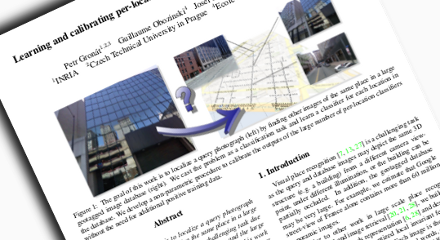Datasets and evaluation:
We provide data set on request by email. Please mail to name.surename@inria.fr (please replace name and surname by the first author's name).
Database:
We performed experiments on a database of Google Streetview images from the Internet [1]. We downloaded panoramas from Pittsburgh (U.S.) covering roughly an area of 1.3x1.3 km^2. For each panorama we generate 12 overlapping perspective views corresponding to two different elevation angles 4deg and 24deg to capture both the street-level scene and the building facades. This results in a total of 24 perspective views each with 90deg FOV and resolution of 960x720 pixels. The dataset contains in 25k perspective images.
Query set:
As a query set with known ground truth GPS positions, we use 8999 panoramas from the Google Streetview research dataset [2], which cover approximately the same area, but were captured at a different time, and typically depict the same places from different viewpoints and under different illumination conditions. We generate a test query set such that we first select a panorama at random, and second, we generate a perspective image with a random orientation and random elevation pitch. This way we synthesize 4,000 query test images.
[1] Building streetview datasets for place recognition and city reconstruction, P. Gronat, M. Havlena, J. Sivic, T. Pajdla, Tech. Rep. CTU-CMP-2011-16, Czech Tech University.
[2] Google company,"ICMLA 2011 StreetView Recognition Challenge", http://www.icmla-conference.org/icmla11/challenge.htm.
